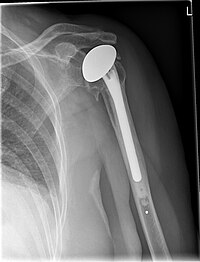
Photo from wikipedia
INTRODUCTION In shoulder arthroplasty, ultra-high-molecular-weight polyethylene is used as standard material for glenoid components. The emergence of wear particles and their influence on the aseptic loosening of joint replacements are… Click to show full abstract
INTRODUCTION In shoulder arthroplasty, ultra-high-molecular-weight polyethylene is used as standard material for glenoid components. The emergence of wear particles and their influence on the aseptic loosening of joint replacements are well known. The aim of the present study is to investigate the wear behaviour of the implant combinations as well as the size and morphology of the released wear particles from novel anatomic shoulder prosthesis. Here, the main interest lies on the influence of material inversion and different conformities on wear behaviour. METHODS Wear simulation was performed using a force-controlled joint simulator. The Modular-Shoulder-System from Permedica S.p.A. Orthopaedics was studied. Polyethylene wear was determined gravimetrically and was characterised by particle analysis. An abduction-adduction motion of 0°-90° lifting a load of 2 kg superimposed by an ante-/retroversion was chosen as the activity. In addition, an extreme test was performed to simulate subluxation of the joint. RESULTS The results showed a wear reduction of approximately 70% and a significant decrease in the total number of wear particles due to the material inversion on the bearing materials. No reduction of wear could be determined by varying the conformity of the bearing partners. In the simulated subluxation, the material inversion shows an increase in wear. CONCLUSION Compared to similarly investigated systems, the Modular-Shoulder-System shows a reduction in wear. This reduction shows that material inversion may lead to a wear reduction. However, if subluxation of the humeral head occurs more frequently, increased material wear can be expected with the Modular-Shoulder-System. An influence of the conformity on the wear behaviour could not be determined.
Journal Title: Journal of the mechanical behavior of biomedical materials
Year Published: 2022
Link to full text (if available)
Share on Social Media: Sign Up to like & get
recommendations!